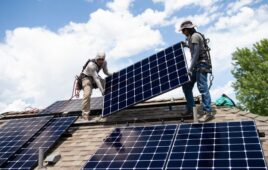LFP energy storage manufacturer SimpliPhi Power has partnered with Heila Technologies to deploy intelligent energy storage + solar systems at a demonstration project in Shreveport, Louisiana, with the support of Southwestern Electric Power Co. (SWEPCO), an American Electric Power (AEP) company.
 “Behind-the-meter energy storage is a cost-effective way to help utilities and customers alike manage their electricity usage with the security of knowing they have access to stored energy that can be seamlessly integrated into the grid or islanded during power outages,” said SimpliPhi Power’s CEO Catherine Von Burg.
“Behind-the-meter energy storage is a cost-effective way to help utilities and customers alike manage their electricity usage with the security of knowing they have access to stored energy that can be seamlessly integrated into the grid or islanded during power outages,” said SimpliPhi Power’s CEO Catherine Von Burg.
The demonstration project with Heila Technologies will aggregate distributed energy resources and allow SWEPCO to manage these assets as an optimized fleet. Under a single platform, SWEPCO will be able to leverage the solar + storage systems to correct power factor, perform peak shaving and manage overall energy supply, all while improving customer resiliency. Building resiliency for utility customers using renewable power generation plus storage will be key as the Southeast United States continues to see an increase in extreme weather events due to the impacts of climate change.
Heila’s Senior Engineer and Co-Founder, Jorge Elizondo shared, “The Heila Platform is able to sense changes across all connected components and make the system holistically and automatically respond to the changing conditions of the electrical grid. With SimpliPhi, we have found a safe and high performing battery that is ready to be deployed at scale to make this vision a reality.”
The SimpliPhi+Heila solution, consists of PHI 3.8-kWh batteries, inverter(s), and a Heila EDGE controller which acts as a battery management system (BMS) and an energy management system (EMS). Any and all distributed energy resources (DERs) controlled by a Heila EDGE in a system are then aggregated and optimized to form a distributed intelligent network that can be used by any central controller, ADMS or SCADA to control the fleet as a single entity using common protocols.
The PHI batteries measure and report voltage, current and temperatures, and perform useful calculations to determine real-time battery state of charge (SoC), state of health (SoH) and fault detection. Heila is programmed to operate the PHI battery units in either grid-connected or off-grid mode, and manage transitions between modes, enabling full control of the flow of real and reactive power to and from the grid, load curtailment, and more. The utility or grid operator can set performance objectives at the aggregate level, rather than on a DER-by-DER basis and collect real-time and historical data from all systems to streamline grid operations. This project will serve as a model for other stakeholders who are interested in the benefits of decentralized energy generation and storage working as a virtual power plant.
News item from SimpliPhi





The value of aggregating roof solar with energy building in new subdivisions to one collector site equalizes the unit demand for power. Obstructions and shading considerations as well as orientation are the consideration in a proper overall design of a development. Added storage could make the system independent of the grid, even impervious to the grid. Surplus power stored and left over would sell to others or the grid. Design considerations must include O&M for the life of the project. A proper ‘green energy’ development would be less costly, self sufficient, impervious to grid failure and most of all happy individual owners making one’s house a home not to enjoy for life.
There are some aggregate solar PV with smart ESS developments going in, at least in the South West states. Developer Mandalay is building housing tracts with solar PV and ESS in every home in the tract. One development in Prescott Az when built out will be somewhere around 2,900 homes and an aggregate 30 to 40MWh of energy storage. Mandalay has already negotiated an energy storage agreement with utility APS to use the developments aggregate energy storage to take over generation from the Palo Verde Nuclear plant during the off peak time of day between 2 AM and 5 AM to allow the plant to continue generating power at its peak generation efficiency.
This could well be the future of housing in the U.S.. With overall costs of solar PV and energy storage coming down, even old housing tracts could be upgraded into aggregate solar PV and energy storage communities.